Wayne Liu (劉文川) was outraged when he learned that his ancestor’s tomb was going to be destroyed. The grave’s removal, one of an estimated 2,400 that will disappear when the New Taipei City government razes the cemetery where it’s located, will erase any trace of his family’s history here, as well as the cemetery’s 270-year old history.
“My ancestors have been buried here for five generations,” Liu tells the Taipei Times, as he motions past a metal fence that now surrounds the public cemetery to a large yellow excavator that has already demolished part of it. Broken gravestones and shards of funerary objects lay scattered everywhere.
“But it’s [not only] my family’s tomb,” he says. “It is important … to preserve the cemetery for its cultural and historic [value].”
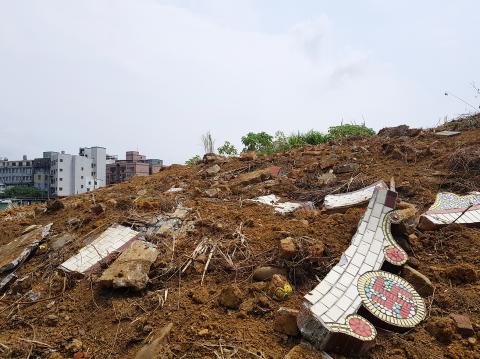
Photo: Noah Buchan, Taipei times
Liu is among a group of academics, amateur historians, activists and local residents calling themselves Sindian Cemetery Heritage (搶救新店的墓園), who have spent the past three years lobbying the New Taipei City government to preserve the six-hectare cemetery (about the size of six sports fields) in Sindian District (新店).
But there is little incentive for the government to do so. The valuable land, which is located close to industrial and residential areas, will almost certainly be zoned for development. Combined with strong cultural taboos regarding the pollution of death associated with graveyards, the preservationists face an uphill struggle to save it and the tombs that hold the history of nearly three centuries of Han Chinese migration to the area and their burial practices.
CULTURAL HERITAGE VS ECONOMIC DEVELOPMENT
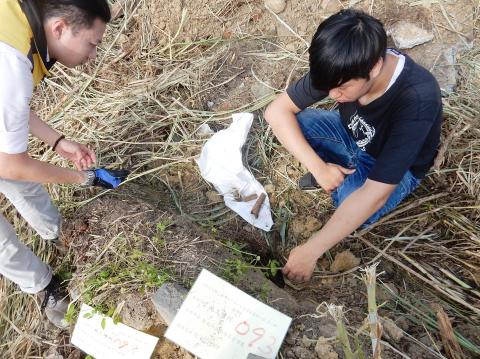
PhotO courtesy of James Morris
Dating back to 1770s, the Sindian First Public Cemetery (新店第一公墓) is the city’s oldest and holds valuable clues to the many different peoples who have lived there.
Wu Bo-wei (吳柏瑋), an activist and a Tree Party candidate for city councilor in the November elections whose ancestors arrived in Sindian over 200 years ago, says the cemetery is a powerful reminder of Taiwan’s colonial history. It contains graves from the Qing Dynasty, when the area was first opened up for cultivation under the Qianlong Emperor, to the Japanese colonial era and the arrival of the Chinese Nationalist Party (KMT) after World War II.
“The cemetery shows in great detail the funerary practices of those who have come to Taiwan, the materials they used to construct the graves and the positions of the graves. All this has to do with our people and their livelihood, with Taiwan’s history,” he says.
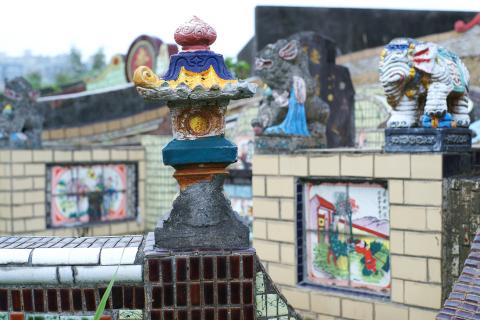
Photo: Noah Buchan, Taipei times
The problem for preservationists, says David Blundell, an anthropologist at National Chengchi University and one of the academics spearheading the preservation efforts, is that the mortuary department has been tasked with demolishing the cemetery, and its only concern is with the contents of the tombs — corpses and bones.
“The [mortuary department] has the right to destroy the tombstones, but it doesn’t have the right to preserve the tombstones,” Blundell says.
That responsibility falls under the purview of New Taipei City’s Cultural Affairs Bureau, which has expressed little interest in taking up the mantle of protector.
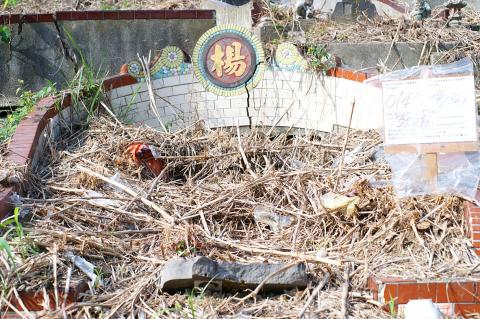
Photo: Noah Buchan, Taipei times
“The government is dragging its feet by appealing to the fact that people of Chinese descent do not typically preserve cemeteries … because graves are typically seen as taboo,” Wu says.
Indeed, an employee with the New Taipei City’s Mortuary Services Office, who asked for his name to be withheld because he’s not authorized to speak with the media, tells the Taipei Times that the government has received several complaints from local residents, who say that the cemetery is a spooky eyesore.
The Mortuary Services Office employee adds that consequently many of the over 190 public cemeteries in the city will follow the same fate.
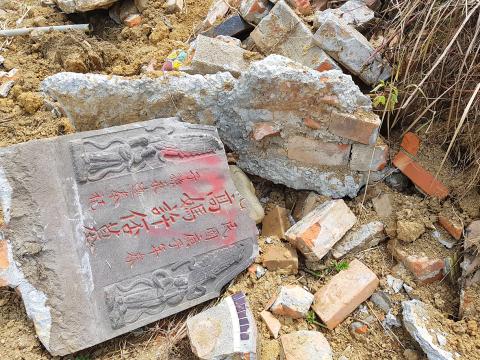
Photo: Noah Buchan, Taipei times
However, there are several graveyards in Taipei younger than Sindian’s that contain tombs that have been designated historic sites and have become popular tourist attractions, such as the tomb of general Pai Chung-hsi (白崇禧) and Chiang Wei-shui (蔣渭水), the “Sun Yat-sen of Taiwan.”
But, the Cultural Affairs Bureau is using the cemetery’s age as a reason to justify why it doesn’t need to be preserved, according to a report on it’s Web site.
PUBLIC HEARING
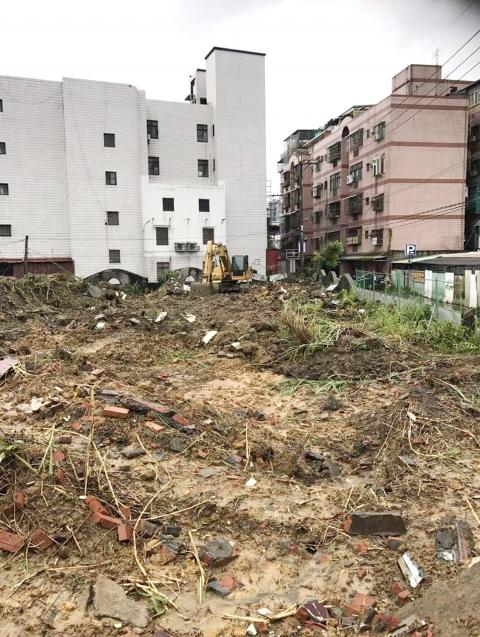
Photo Courtesy of James Morris
The preservationists in May presented their concerns at a public hearing, including officials from the culture and economic bureaus, that would decide the fate of the cemetery. Though the hearing was open to the public, Wu says that the government employed several strategies to restrict public involvement, “such as attendance registration, speech registration and even requiring identification before entering the event.”
Liu, who also attended, says that, unlike similar hearings held by Taipei’s Department of Culture, there was no discussion or debate, they weren’t allowed to record or take pictures and, after they presented their case, were shooed out of the room before the cemetery’s fate was decided.
“They then snuck out the back door without informing us of their decision,” Liu says.
The Cultural Affairs Bureau then issued a report on its Web site. The report listed many reasons why it should be protected, including that it “displays tradition, ethnicity and local social customs,” and that the cemetery was “connected to the local people who developed the area and historical incidents that reflect political, economic, social and cultural changes over time.”
But its final decision was to demolish it, reasoning: “The whole environment of the cemetery has already been destroyed due to the construction of a highway and urban development, and the bones have already been removed and reburied. Additionally, the surroundings and the structural integrity of the tombs are no longer intact, which does not comply with the registration standards found in the Regulations for the Registration and Supplement of Historical Structures (歷史建築紀念建築登錄廢止審查及輔助辦法).”
The report caused consternation among preservationists who say that it was, in fact, the New Taipei City government that had “destroyed” part of the cemetery for “urban development,” leaving only roughly one-third of it intact.
Preservationist Atlas Yang (楊時睿), who is a Green Party candidate for Taipei City councilor in the upcoming November elections, says that bones had been disinterred after the excavating machines began smashing the tombs earlier this month, evidence that their “relatives weren’t contacted so that the remains could be moved and properly stored.”
“Why did the government disregard such religious traditions and start using heavy machinery,” Yang asks.
After the report was published, the excavators went back to work.
In an attempt to stop the work from continuing, Wu earlier this month stood in front of the excavator. The stunt worked, and the media attention that he generated caught the attention of the Ministry of Culture, which halted the demolition.
But Wu isn’t hopeful that the demolition will cease permanently.
“When faced with development, especially development pushed by the government, the public has no power. And this is too large [a piece of land] to just let go.”
FUNERARY OBJECTS
When preservationists learned that the cemetery was to be demolished, part of it had already been razed and turned into a park. Realizing that its total removal was inevitable, they turned their efforts to saving culturally significant funerary objects and tombstones.
But even here, they faced an obstinate New Taipei City.
Blundell says that Chengchi University agreed to set aside space for the more valuable objects.
“We’ve found 100 rare and impressive tombstones and another 50 that need to be rescued,” he told the Taipei Times last year when most of the remaining part of the cemetery was still untouched.
Blundell says that New Taipei City agreed to move several of the objects to the university, but then later demanded that they be returned due to jurisdictional reasons because “the tombstones are the property of New Taipei City and they were moved to Taipei,” where the university is located.
Their whereabouts remain unknown.
Blundell adds that the Museum of World Religion also agreed to take any object that the academics deemed worthy of preservation, but later backtracked over legal concerns.
MAPPING TOMBS FOR POSTERITY
As it became apparent to the academics that the government was hindering their conservation efforts, Oliver Streiter began surveying the cemetery and gathering GPS data on the location of all the tombs.
Streiter, an associate professor at National University of Kaohsiung and a contributor to Thakbong, a Web resource and database that documents the funerary practices in Taiwan and Han Chinese across Asia, says that the cemetery in New Taipei City is a specific example of a more general trend by local governments throughout the nation to remove cemeteries — some dating back to the Ming Dynasty.
To gain a sense of the scale of Taiwan’s systematic cemetery removal effort, in Kaohsiung alone, Streiter has amassed a database of over 100,000 photos and videos depicting the removal of 6,000 graves.
Streiter says that Hawaii and Hong Kong have well maintained cemeteries, popular with tourists.
“It is strange that the Chinese in Hawaii take more care of their ancestors than the Chinese here in Taiwan,” he says.
Back at the Sindian public cemetery, the excavators have been given the okay to demolish the rest of the cemetery, finishing the job last week.
Yang, at his wits end, appeals to fate: “According to our tradition, this is inauspicious for our future generations. They might face poverty, or illness or death. These developers operate under the same belief system — but they are willing, for money and short term benefits, to destroy other people’s graves.”
Today, nothing remains of the centuries-old cemetery except shards of funerary art poking out of the exposed earth. The only remaining evidence of the tombs are pictures, their location an online database.
“What will people think 50 years from now,” Liu asks.
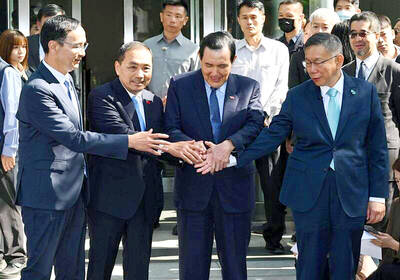
Has the Taiwan People’s Party (TPP) changed under the leadership of Huang Kuo-chang (黃國昌)? In tone and messaging, it obviously has, but this is largely driven by events over the past year. How much is surface noise, and how much is substance? How differently party founder Ko Wen-je (柯文哲) would have handled these events is impossible to determine because the biggest event was Ko’s own arrest on multiple corruption charges and being jailed incommunicado. To understand the similarities and differences that may be evolving in the Huang era, we must first understand Ko’s TPP. ELECTORAL STRATEGY The party’s strategy under Ko was
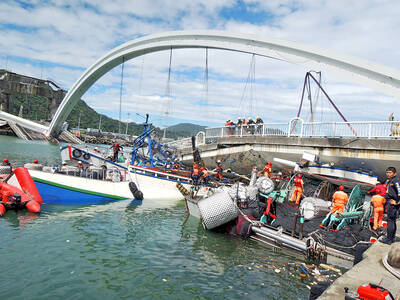
Before the recall election drowned out other news, CNN last month became the latest in a long line of media organs to report on abuses of migrant workers in Taiwan’s fishing fleet. After a brief flare of interest, the news media moved on. The migrant worker issues, however, did not. CNN’s stinging title, “Taiwan is held up as a bastion of liberal values. But migrant workers report abuse, injury and death in its fishing industry,” was widely quoted, including by the Fisheries Agency in its response. It obviously hurt. The Fisheries Agency was not slow to convey a classic government
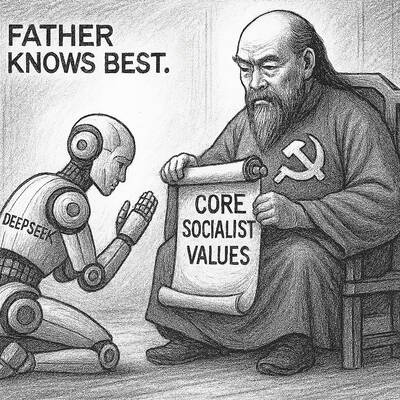
It’s Aug. 8, Father’s Day in Taiwan. I asked a Chinese chatbot a simple question: “How is Father’s Day celebrated in Taiwan and China?” The answer was as ideological as it was unexpected. The AI said Taiwan is “a region” (地區) and “a province of China” (中國的省份). It then adopted the collective pronoun “we” to praise the holiday in the voice of the “Chinese government,” saying Father’s Day aligns with “core socialist values” of the “Chinese nation.” The chatbot was DeepSeek, the fastest growing app ever to reach 100 million users (in seven days!) and one of the world’s most advanced and
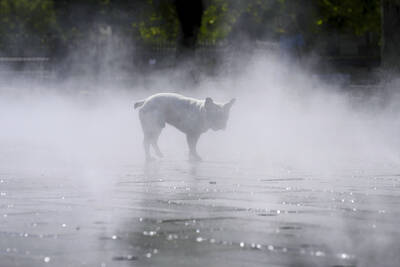
It turns out many Americans aren’t great at identifying which personal decisions contribute most to climate change. A study recently published by the National Academy of Sciences found that when asked to rank actions, such as swapping a car that uses gasoline for an electric one, carpooling or reducing food waste, participants weren’t very accurate when assessing how much those actions contributed to climate change, which is caused mostly by the release of greenhouse gases that happen when fuels like gasoline, oil and coal are burned. “People over-assign impact to actually pretty low-impact actions such as recycling, and underestimate the actual carbon